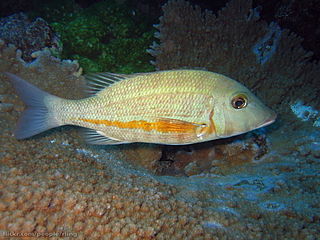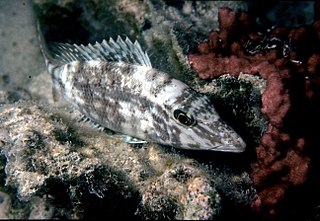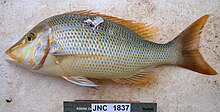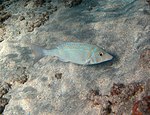
Lethrinidae are a family of ray-finned fishes belonging to the order Spariformes commonly known as emperors, emperor breams, and pigface breams.

Lethrinus miniatus, the trumpet emperor, redthroat emperor, sweetlip emperor, Sweetlip Swoose, island snapper, yellowmouth perch, yellowmouth snapper, lipper or nannygal, is a species of marine ray-finned fish belonging to the family Lethrinidae, the emperors and emperor breams. This species is found the eastern Indo-West Pacific region.

Lutjanidae, or snappers are a family of perciform fish, mainly marine, but with some members inhabiting estuaries, feeding in fresh water. The family includes about 113 species. Some are important food fish. One of the best known is the red snapper.

Lethrinus laticaudis, the grass emperor, blue-lined emperor, blue-spotted emperor, brown kelp-fish, brown morwong, brown sweetlip, coral bream, grass sweetlip, grey sweetlip, piggy, red throat, red-finned emperor, snapper bream, squire, sweet-lips or tricky snapper, is a species of marine ray-finned fish belonging to the family Lethrinidae, the emperors and emperor breams. This fish is found in the eastern Indian and western Pacific Oceans.

Calydiscoides euzeti is a species of monogenean of the family Diplectanidae.

Lethrinus is a genus of marine ray-finned fishes belonging to the family Lethrinidae, the emperors and emperor breams. These fishes are mostly found in the Indian and western Pacific Oceans, with a single species in the eastern Atlantic Ocean.

Lethrinus obsoletus, the orange-striped emperor, yellow-banded emperor or yellowstripe emperor, is a species of marine ray-finned fish belonging to the family Lethrinidae, the emperors or emperor breams. This species has a wide Indo-Pacific distribution.

Lethrinus atkinsoni, the Pacific yellowtail emperor,, Atkinson's emperor, reticulated emperor, tricky snapper, Tuamotu emperor, yellow morwong or yellow-tailed emperor is a species of marine ray-finned fish benomging to the family Lethrinidae, the emperor breams and emperors. This fish is found in the Western Pacific Ocean.

Lethrinus harak, the thumbprint emperorblackblotch emperor or blackspot emperor, is a species of marine ray-finned fish belonging to the Family Lethrinidae. the emperors and emperor breams. This species is found in the Indo-Pacific region.

Lethrinus lentjan, the pink ear emperor, redspot emperor, purple ear emperor or purple-headed emperor, is a species of marine ray-finned fish belonging to the family Lethrinidae, the emperors and emperor breams. This fish is found in the Indo-Pacific region.

Lethrinus mahsena, common names the sky emperor, mahsena emperor, and cutthroat emperor, is a species of emperor fish. It grows to 65 cm (26 in) in length, but is commonly found at between 35 and 45 cm. This fish may be yellow to greenish-blue or olive-grey, becoming paler toward the belly. It is a non-migratory, reef-associated fish that has a high commercial value.

Lethrinus microdon, the smalltooth emperor, longface emperor or pigface bream, is a species of marine ray-finned fish belonging to the family Lethrinidae, the emperors and emperor breams. This species has a widespread distribution in the Indo-Pacific.
Lethrinus scoparius is a species of marine ray-finned fish belonging to the family Lethrinidae, the emperors and emperor breams. This species is found in the southwestern Indian Ocean. L. scoparius was previously considered to be a junior synonyms of L. nebulosus.

Lethrinus rubrioperculatus,the spotcheek emperor, red-eared emperor, red-ears, red-edged emperor, scarlet-cheek emperor, and spot cheek emperor, is a species of marine ray-finned fish belonging to the family Lethrinidae, the emperors or emperor breams. This species has a wide Indo-Pacific distribution.

Pseudorhabdosynochus is a genus of monopisthocotylean monogeneans, included in the family Diplectanidae. The type-species of the genus is Pseudorhabdosynochus epinepheli .
Calydiscoides is a genus of monopisthocotylean monogeneans, included in the family Diplectanidae.

Hamacreadium cribbi is a species of digenean, parasitic in the lethrinid fish Lethrinus miniatus. The species was collected off New Caledonia.
Lethrinitrema is a genus of monogeneans belonging to the family Ancyrocephalidae. The genus was created by Susan Lim and Jean-Lou Justine in 2011 for parasites of lethrinid fish from New Caledonia. All members of the genus are parasitic on the gills of fish.

Jean-Lou Justine, French parasitologist and zoologist, is a professor at the National Museum of Natural History in Paris, France, and a specialist of fish parasites and invasive land planarians.

Lethrinus borbonicus, the snubnose emperor, is a species of marine ray-finned fish belonging to the family Lethrinidae, the emperor breams and emperors. This species is found in the Western Indian Ocean and is of some importance to commercial fisheries in that region.


















